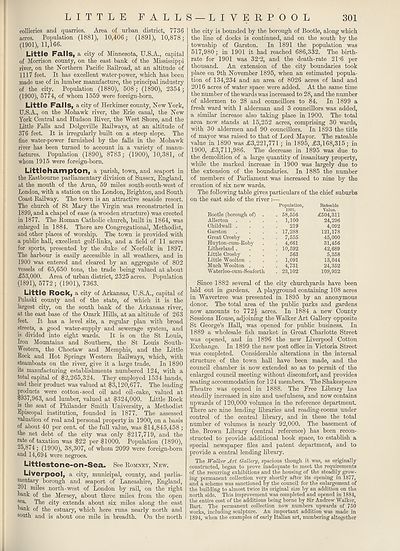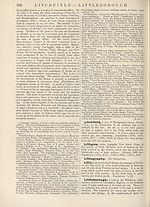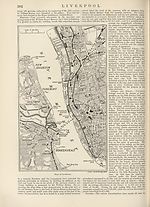New volumes of the Encyclopædia Britannica > Volume 30, K-MOR
(331) Page 301 - LIT
Download files
Complete book:
Individual page:
Thumbnail gallery: Grid view | List view

301
LITTLE FALLS — LIVERPOOL
collieries and quarries. Area of urban district, 7736
acres. Pojmlation (1881), 10,406; (1891), 10,878;
(1901), 11,166.
Little Falls, a city of Minnesota, U.S.A., capital
of Morrison county, on the east bank of the Mississippi
river, on the Northern Pacific Railroad, at an altitude of
1117 feet. It has excellent water-power, which has been
made use of in lumber manufacture, the principal industry
of the city. Population (1880), 508 ; (1890), 2354;
(1900), 5774, of whom 1559 were foreign-born.
Little Falls, a city of Herkimer county, New York,
U.S.A., on the Mohawk river, the Erie canal, the New
York Central and Hudson River, the West Shore, and the
Little Falls and Dolgeville Railways, at an altitude of
376 feet. It is irregularly built on a steep slope. The
fine water-power furnished by the falls in the Mohawk
river has been turned to account in a variety of manu¬
factures. Population (1890), 8783; (1900), 10,381, of
whom 1915 were foreign-born.
Littlehampton, a parish, town, and seaport in
the Eastbourne parliamentary division of Sussex, England,
at the mouth of the Arun, 59 miles south-south-west of
London, with a station on the London, Brighton, and South
Coast Railway. The town is an attractive seaside resort.
The church of St Mary the Virgin was reconstructed in
1899, and a chapel of ease (a wooden structure) was erected
in 1877. The Roman Catholic church, built in 1864, was
enlarged in 1884. There are Congregational, Methodist,
and other places of worship. The town is provided with
a public hall, excellent golf-links, and a field of 11 acres
for sports, presented by the duke of Norfolk in 1897.
The harbour is easily accessible in all weathers, and in
1900 was entered and cleared by an aggregate of 802
vessels of 65,650 tons, the trade being valued at about
£53,000. Area of urban district, 2325 acres. Population
(1891), 5772; (1901), 7363.
Little Rock, a city of Arkansas, U.S.A., capital of
Pulaski county and of the state, of which it is the
largest city, on the south bank of the Arkansas river,
at the east base of the Ozark Hills, at an altitude of 263
feet. It has a level site, a regular plan with broad
streets, a good water-supply and sewerage system, and
is divided into eight wards. It is on the St Louis,
Iron Mountains and Southern, the St Louis South-
Western, the Choctaw and Memphis, and the Little
Rock and Hot Springs Western Railways, which, with
steamboats on the river, give it a large trade. In 1890
its manufacturing establishments numbered 124, with a
total capital of $2,265,324. They employed 1534 hands,
and their product was valued at $3,120,677. The leading
products were cotton-seed oil and oil-cake, valued at
$937,963, and lumber, valued at $324,000. Little Rock
is the seat of Philander Smith University, a Methodist
Episcopal institution, founded in 1877. The assessed
valuation of real and personal property in 1900, on a basis
of about 40 per cent, of the full value, was $14,845,458 ;
the net debt of the city was only $217,719, and the
rate of taxation was $22 per $1000. Population (1890),
25,874; (1900), 38,307, of whom 2099 were foreign-born
and 14,694 were negroes.
Littlestone-on-Sea. See Romney, New.
Liverpool, a city, municipal, county, and parlia¬
mentary borough and seaport of Lancashire, England,
201 miles north-west of London by rail, on the right
bank of the Mersey, about three miles from the open
sea. The city extends about six miles along the east
bank of the estuary, which here runs nearly north and
south and is about one mile in breadth. On the north
the city is bounded by the borough of Bootle, along which
the line of docks is continued, and on the south by the
township of Garston. In 1891 the population was
517,980; in 1901 it had reached 686,332. The birth¬
rate for 1901 was 32‘2, and the death-rate 21-6 per
thousand. An extension of the city boundaries took
place on 9th November 1895, when an estimated popula¬
tion of 134,234 and an area of 8026 acres of land and
2016 acres of water space were added. At the same time
the number of the wards was increased to 28, and the number
of aldermen to 28 and councillors to 84. In 1899 a
fresh ward with 1 alderman and 3 councillors was added,
a similar increase also taking place in 1900. The total
area now stands at 15,252 acres, comprising 30 wards,
with 30 aldermen and 90 councillors. In 1893 the title
of mayor was raised to that of Lord Mayor. The rateable
value in 1890 was £3,221,771 ; in 1895, £3,168,315; in
1900, £3,711,986. The decrease in 1895 was due to
the demolition of a large quantity of insanitary property,
while the marked increase in 1900 was largely due to
the extension of the boundaries. In 1885 the number
of members of Parliament was increased to nine by the
creation of six new wards.
The following table gives particulars of the chief suburbs
on the east side of the river:—
Bootle (borough of)
Allerton
Childwall .
Garston
Great Crosby
Huyton-cum-B.oby
Litherland .
Little Crosby
Little Woolton .
Much Woolton .
Waterloo-cum-Seaforth
Population, Rateable
1901. Value.
58,556 £504,311
1,100 24,296
219 4,092
17,288 121,178
7,555 45,000
4,661 31,456
10,592 42,689
563 5,358
1,091 13,044
4,731 24,352
23,102 109,932
Since 1882 several of the city churchyards have been
laid out in gardens. A playground containing 108 acres
in Wavertree was presented in 1895 by an anonymous
donor. The total area of the public parks and gardens
now amounts to 772| acres. In 1884 a new County
Sessions House, adjoining the Walker Art Gallery opposite
St George’s Hall, was opened for public business. In
1889 a wholesale fish market in Great Charlotte Street
was opened, and in 1896 the new Liverpool Cotton
Exchange. In 1899 the new post office in Victoria Street
was completed. Considerable alterations in the internal
structure of the town hall have been made, and the
council chamber is now extended so as to permit of the
enlarged council meeting without discomfort, and provides
seating accommodation for 124 members. The Shakespeare
Theatre was opened in 1888. The Free Library has
steadily increased in size and usefulness, and now contains
upwards of 120,000 volumes in the reference department.
There are nine lending libraries and reading-rooms under
control of the central library, and in these the total
number of volumes is nearly 92,000. The basement of
theN Brown Library (central reference) has been recon¬
structed to provide additional book space, to establish a
special newspaper files and patent department, and to
provide a central lending library.
The Walker Art Gallery, spacious though it was, as originally
constructed, began to prove inadequate to meet the requirements
of the recurring exhibitions and the housing of the steadily grow¬
ing permanent collection very shortly after its opening in 1877,
and a scheme was sanctioned by the council for the enlargement of
the building to almost twice its original size by an addition on the
north side. This improvement was completed and opened in 1884,
the entire cost of the additions being borne by Sir Andrew Walker,
Bart. The permanent collection now numbers upwards of 750
works, including sculpture. An important addition was made in
1894, when the examples of early Italian art, numbering altogether
LITTLE FALLS — LIVERPOOL
collieries and quarries. Area of urban district, 7736
acres. Pojmlation (1881), 10,406; (1891), 10,878;
(1901), 11,166.
Little Falls, a city of Minnesota, U.S.A., capital
of Morrison county, on the east bank of the Mississippi
river, on the Northern Pacific Railroad, at an altitude of
1117 feet. It has excellent water-power, which has been
made use of in lumber manufacture, the principal industry
of the city. Population (1880), 508 ; (1890), 2354;
(1900), 5774, of whom 1559 were foreign-born.
Little Falls, a city of Herkimer county, New York,
U.S.A., on the Mohawk river, the Erie canal, the New
York Central and Hudson River, the West Shore, and the
Little Falls and Dolgeville Railways, at an altitude of
376 feet. It is irregularly built on a steep slope. The
fine water-power furnished by the falls in the Mohawk
river has been turned to account in a variety of manu¬
factures. Population (1890), 8783; (1900), 10,381, of
whom 1915 were foreign-born.
Littlehampton, a parish, town, and seaport in
the Eastbourne parliamentary division of Sussex, England,
at the mouth of the Arun, 59 miles south-south-west of
London, with a station on the London, Brighton, and South
Coast Railway. The town is an attractive seaside resort.
The church of St Mary the Virgin was reconstructed in
1899, and a chapel of ease (a wooden structure) was erected
in 1877. The Roman Catholic church, built in 1864, was
enlarged in 1884. There are Congregational, Methodist,
and other places of worship. The town is provided with
a public hall, excellent golf-links, and a field of 11 acres
for sports, presented by the duke of Norfolk in 1897.
The harbour is easily accessible in all weathers, and in
1900 was entered and cleared by an aggregate of 802
vessels of 65,650 tons, the trade being valued at about
£53,000. Area of urban district, 2325 acres. Population
(1891), 5772; (1901), 7363.
Little Rock, a city of Arkansas, U.S.A., capital of
Pulaski county and of the state, of which it is the
largest city, on the south bank of the Arkansas river,
at the east base of the Ozark Hills, at an altitude of 263
feet. It has a level site, a regular plan with broad
streets, a good water-supply and sewerage system, and
is divided into eight wards. It is on the St Louis,
Iron Mountains and Southern, the St Louis South-
Western, the Choctaw and Memphis, and the Little
Rock and Hot Springs Western Railways, which, with
steamboats on the river, give it a large trade. In 1890
its manufacturing establishments numbered 124, with a
total capital of $2,265,324. They employed 1534 hands,
and their product was valued at $3,120,677. The leading
products were cotton-seed oil and oil-cake, valued at
$937,963, and lumber, valued at $324,000. Little Rock
is the seat of Philander Smith University, a Methodist
Episcopal institution, founded in 1877. The assessed
valuation of real and personal property in 1900, on a basis
of about 40 per cent, of the full value, was $14,845,458 ;
the net debt of the city was only $217,719, and the
rate of taxation was $22 per $1000. Population (1890),
25,874; (1900), 38,307, of whom 2099 were foreign-born
and 14,694 were negroes.
Littlestone-on-Sea. See Romney, New.
Liverpool, a city, municipal, county, and parlia¬
mentary borough and seaport of Lancashire, England,
201 miles north-west of London by rail, on the right
bank of the Mersey, about three miles from the open
sea. The city extends about six miles along the east
bank of the estuary, which here runs nearly north and
south and is about one mile in breadth. On the north
the city is bounded by the borough of Bootle, along which
the line of docks is continued, and on the south by the
township of Garston. In 1891 the population was
517,980; in 1901 it had reached 686,332. The birth¬
rate for 1901 was 32‘2, and the death-rate 21-6 per
thousand. An extension of the city boundaries took
place on 9th November 1895, when an estimated popula¬
tion of 134,234 and an area of 8026 acres of land and
2016 acres of water space were added. At the same time
the number of the wards was increased to 28, and the number
of aldermen to 28 and councillors to 84. In 1899 a
fresh ward with 1 alderman and 3 councillors was added,
a similar increase also taking place in 1900. The total
area now stands at 15,252 acres, comprising 30 wards,
with 30 aldermen and 90 councillors. In 1893 the title
of mayor was raised to that of Lord Mayor. The rateable
value in 1890 was £3,221,771 ; in 1895, £3,168,315; in
1900, £3,711,986. The decrease in 1895 was due to
the demolition of a large quantity of insanitary property,
while the marked increase in 1900 was largely due to
the extension of the boundaries. In 1885 the number
of members of Parliament was increased to nine by the
creation of six new wards.
The following table gives particulars of the chief suburbs
on the east side of the river:—
Bootle (borough of)
Allerton
Childwall .
Garston
Great Crosby
Huyton-cum-B.oby
Litherland .
Little Crosby
Little Woolton .
Much Woolton .
Waterloo-cum-Seaforth
Population, Rateable
1901. Value.
58,556 £504,311
1,100 24,296
219 4,092
17,288 121,178
7,555 45,000
4,661 31,456
10,592 42,689
563 5,358
1,091 13,044
4,731 24,352
23,102 109,932
Since 1882 several of the city churchyards have been
laid out in gardens. A playground containing 108 acres
in Wavertree was presented in 1895 by an anonymous
donor. The total area of the public parks and gardens
now amounts to 772| acres. In 1884 a new County
Sessions House, adjoining the Walker Art Gallery opposite
St George’s Hall, was opened for public business. In
1889 a wholesale fish market in Great Charlotte Street
was opened, and in 1896 the new Liverpool Cotton
Exchange. In 1899 the new post office in Victoria Street
was completed. Considerable alterations in the internal
structure of the town hall have been made, and the
council chamber is now extended so as to permit of the
enlarged council meeting without discomfort, and provides
seating accommodation for 124 members. The Shakespeare
Theatre was opened in 1888. The Free Library has
steadily increased in size and usefulness, and now contains
upwards of 120,000 volumes in the reference department.
There are nine lending libraries and reading-rooms under
control of the central library, and in these the total
number of volumes is nearly 92,000. The basement of
theN Brown Library (central reference) has been recon¬
structed to provide additional book space, to establish a
special newspaper files and patent department, and to
provide a central lending library.
The Walker Art Gallery, spacious though it was, as originally
constructed, began to prove inadequate to meet the requirements
of the recurring exhibitions and the housing of the steadily grow¬
ing permanent collection very shortly after its opening in 1877,
and a scheme was sanctioned by the council for the enlargement of
the building to almost twice its original size by an addition on the
north side. This improvement was completed and opened in 1884,
the entire cost of the additions being borne by Sir Andrew Walker,
Bart. The permanent collection now numbers upwards of 750
works, including sculpture. An important addition was made in
1894, when the examples of early Italian art, numbering altogether
Set display mode to:
![]() Universal Viewer |
Universal Viewer | ![]() Mirador |
Large image | Transcription
Mirador |
Large image | Transcription
Images and transcriptions on this page, including medium image downloads, may be used under the Creative Commons Attribution 4.0 International Licence unless otherwise stated. ![]()
| Encyclopaedia Britannica > New volumes of the Encyclopædia Britannica > Volume 30, K-MOR > (331) Page 301 - LIT |
|---|
| Permanent URL | https://digital.nls.uk/193571804 |
|---|
| Attribution and copyright: |
|
|---|---|
| Shelfmark | EB.18 |
|---|---|
| Description | Ten editions of 'Encyclopaedia Britannica', issued from 1768-1903, in 231 volumes. Originally issued in 100 weekly parts (3 volumes) between 1768 and 1771 by publishers: Colin Macfarquhar and Andrew Bell (Edinburgh); editor: William Smellie: engraver: Andrew Bell. Expanded editions in the 19th century featured more volumes and contributions from leading experts in their fields. Managed and published in Edinburgh up to the 9th edition (25 volumes, from 1875-1889); the 10th edition (1902-1903) re-issued the 9th edition, with 11 supplementary volumes. |
|---|---|
| Additional NLS resources: |
|

